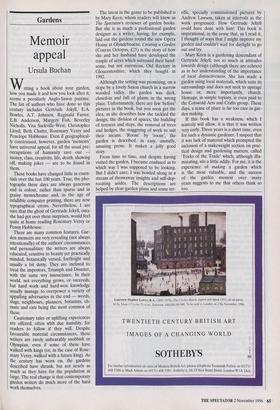Gardens
Memoir appeal
Ursula Buchan
Writing a book about your garden, how you made it and how you look after it, seems a peculiarly Anglo-Saxon pastime. The list of authors who have done so this century includes Gertrude Jekyll, E.A. Bowles, A.T. Johnson, Reginald Farrer, E.B. Anderson, Margery Fish, Beverley Nicholls, Vita Sackville-West, Christopher Lloyd, Beth Chatto, Rosemary Verey and Penelope Hobhouse. Even if geographical- ly constrained, however, garden 'memoirs' have universal appeal, for all the usual pre- occupations of humanity save one money, class, creativity, life, death, showing off, making jokes — are to be found in them.
These books have changed little in essen- tials over the last 100 years. True, the pho- tographs these days are always generous and in colour, rather than sparse and in grainy monochrome and, in the age of infallible computer printing, there are now typographical errors. Nevertheless, I am sure that the ghost of Gertrude Jekyll, once she had got over these surprises, would feel quite at home reading Rosemary Verey or Penny Hobhouse.
There are many common features. Gar- den memoirs are very revealing (not always intentionally) of the authors' circumstances and personalities: the writers are always educated, sensitive to beauty yet practically minded, botanically versed, forthright and usually a bit dotty. They are inclined to treat the impostors, Triumph and Disaster, with the same wry insouciance. In their world, not everything grows, or succeeds, but hard work and hard-won knowledge usually manage to overpower a variety of appalling adversaries in the end — weeds, slugs, neighbours, planners, botanists, cli- mate and cats being the most common of these, Cautionary tales or uplifting experiences are offered, often with due humility, for readers to follow if they will. Despite favourable material circumstances, these writers are rarely unbearably snobbish or Olympian, even if some of them have walked with kings (or, in the case of Rose- mary Verey, walked with a future king). As the century has worn on, the gardens described have shrunk, but not nearly as much as they have for the population at large. The real change is that contemporary garden writers do much more of the hard work themselves. The latest in the genre to be published is by Mary Keen, whom readers will know as The Spectator's reviewer of garden books. But she is as much a professional garden designer as a writer, having, for example, laid out the gardens round the new Opera House at Glyndebourne. Creating a Garden (Conran Octopus, £25) is the story of how she and her husband have developed the couple of acres which surround their hand- some, but not enormous, Old Rectory in Gloucestershire, which they bought in 1992.
Although the setting was promising, on a slope by a lovely Saxon church in a narrow wooded valley, the garden was dark, closed-in and full of plants in the wrong place. Unfortunately, there are few 'before' pictures in the book, but you soon get the idea, as she describes how she tackled the design, the division of spaces, the building of terraces and steps, the removal of trees and hedges, the staggering of work to suit their means. 'Room' by 'room', the garden is described, in easy, unstuffy, amusing prose. It makes a jolly good story.
From time to time, and despite having visited the garden, I became confused as to which way I was supposed to be looking. But I didn't care; I was bowled along in a stream of throwaway insights and self-dep- recating asides. The descriptions are helped by clear garden plans and some ter- rific, specially commissioned pictures by Andrew Lawson, taken at intervals as the work progressed. How Gertrude Jekyll could have done with him! This book is inspirational, in the sense that, as I read it, I thought of ways that I might improve my garden and couldn't wait for daylight to go out and try.
Mary Keen is a gardening descendant of Gertrude Jekyll; not so much in attitudes towards design (although there are echoes) as in her understanding of the importance of local distinctiveness. She has made a garden using local materials, which suits its surroundings and does not seek to upstage house or, more importantly, church. Homage, in simple topiary, is even paid to the Cotswold Arts and Crafts group. These days, a sense of place is far too rare in gar- den making.
If this book has a weakness, which I scarcely will allow, it is that it was written very early. Three years is a short time, even for such a dynamic gardener. I suspect that it was lack of material which prompted the inclusion of a makeweight section on prac- tical design and gardening matters, called `Tricks of the Trade' which, although illu- minating, sits a little oddly. For me, it is the experience of making a garden which is the most valuable, and the success of the garden memoir over many years suggests to me that others think so too.


















































































 Previous page
Previous page